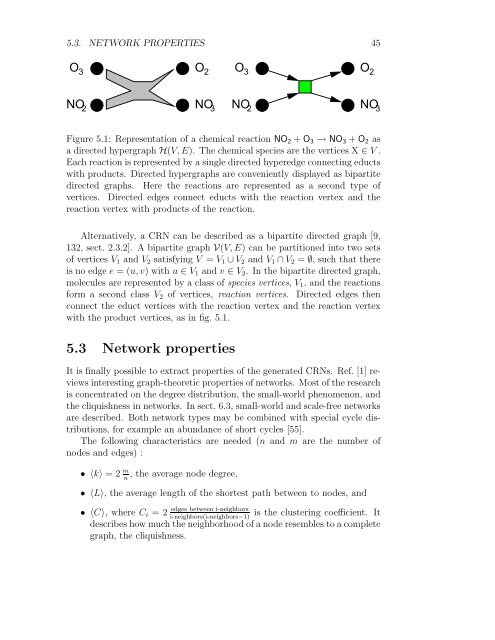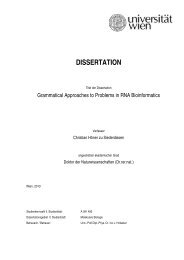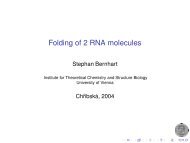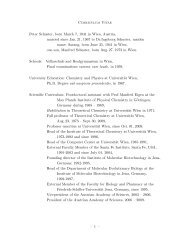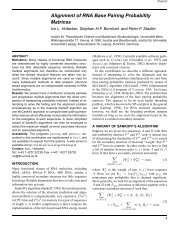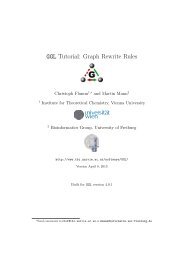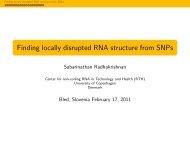A Toy Model of Chemical Reaction Networks - TBI - Universität Wien
A Toy Model of Chemical Reaction Networks - TBI - Universität Wien
A Toy Model of Chemical Reaction Networks - TBI - Universität Wien
You also want an ePaper? Increase the reach of your titles
YUMPU automatically turns print PDFs into web optimized ePapers that Google loves.
5.3. NETWORK PROPERTIES 45<br />
O 3<br />
NO 3<br />
NO 2<br />
O 2<br />
O 3<br />
NO 3<br />
NO 2<br />
O 2<br />
Figure 5.1: Representation <strong>of</strong> a chemical reaction NO 2 + O 3 → NO 3 + O 2 as<br />
a directed hypergraph H(V, E). The chemical species are the vertices X ∈ V .<br />
Each reaction is represented by a single directed hyperedge connecting educts<br />
with products. Directed hypergraphs are conveniently displayed as bipartite<br />
directed graphs. Here the reactions are represented as a second type <strong>of</strong><br />
vertices. Directed edges connect educts with the reaction vertex and the<br />
reaction vertex with products <strong>of</strong> the reaction.<br />
Alternatively, a CRN can be described as a bipartite directed graph [9,<br />
132, sect. 2.3.2]. A bipartite graph V(V, E) can be partitioned into two sets<br />
<strong>of</strong> vertices V 1 and V 2 satisfying V = V 1 ∪ V 2 and V 1 ∩ V 2 = ∅, such that there<br />
is no edge e = (u, v) with u ∈ V 1 and v ∈ V 2 . In the bipartite directed graph,<br />
molecules are represented by a class <strong>of</strong> species vertices, V 1 , and the reactions<br />
form a second class V 2 <strong>of</strong> vertices, reaction vertices. Directed edges then<br />
connect the educt vertices with the reaction vertex and the reaction vertex<br />
with the product vertices, as in fig. 5.1.<br />
5.3 Network properties<br />
It is finally possible to extract properties <strong>of</strong> the generated CRNs. Ref. [1] reviews<br />
interesting graph-theoretic properties <strong>of</strong> networks. Most <strong>of</strong> the research<br />
is concentrated on the degree distribution, the small-world phenomenon, and<br />
the cliquishness in networks. In sect. 6.3, small-world and scale-free networks<br />
are described. Both network types may be combined with special cycle distributions,<br />
for example an abundance <strong>of</strong> short cycles [55].<br />
The following characteristics are needed (n and m are the number <strong>of</strong><br />
nodes and edges) :<br />
• 〈k〉 = 2 m , the average node degree,<br />
n<br />
• 〈L〉, the average length <strong>of</strong> the shortest path between to nodes, and<br />
edges between i-neighbors<br />
• 〈C〉, where C i = 2 is the clustering coefficient. It<br />
i-neighbors(i-neighbors−1)<br />
describes how much the neighborhood <strong>of</strong> a node resembles to a complete<br />
graph, the cliquishness.


